Ahana Ghosh
Synthesizing a Progression of Subtasks for Block-Based Visual Programming Tasks
May 27, 2023
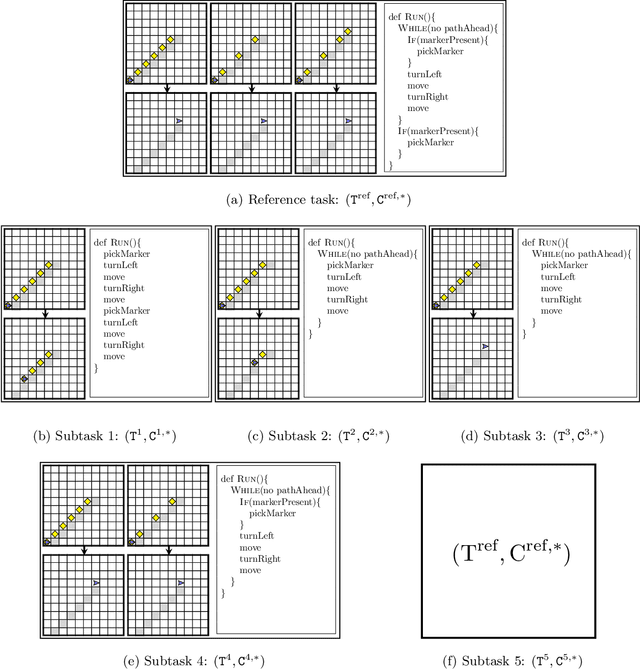
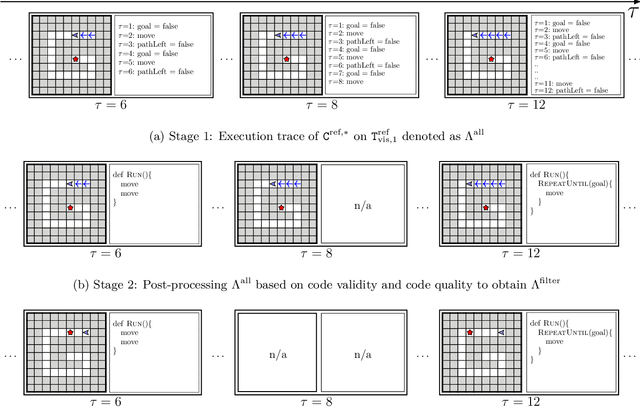

Abstract:Block-based visual programming environments play an increasingly important role in introducing computing concepts to K-12 students. In recent years, they have also gained popularity in neuro-symbolic AI, serving as a benchmark to evaluate general problem-solving and logical reasoning skills. The open-ended and conceptual nature of these visual programming tasks make them challenging, both for state-of-the-art AI agents as well as for novice programmers. A natural approach to providing assistance for problem-solving is breaking down a complex task into a progression of simpler subtasks; however, this is not trivial given that the solution codes are typically nested and have non-linear execution behavior. In this paper, we formalize the problem of synthesizing such a progression for a given reference block-based visual programming task. We propose a novel synthesis algorithm that generates a progression of subtasks that are high-quality, well-spaced in terms of their complexity, and solving this progression leads to solving the reference task. We show the utility of our synthesis algorithm in improving the efficacy of AI agents (in this case, neural program synthesizers) for solving tasks in the Karel programming environment. Then, we conduct a user study to demonstrate that our synthesized progression of subtasks can assist a novice programmer in solving tasks in the Hour of Code: Maze Challenge by Code-dot-org.
Adaptive Scaffolding in Block-Based Programming via Synthesizing New Tasks as Pop Quizzes
Mar 28, 2023Abstract:Block-based programming environments are increasingly used to introduce computing concepts to beginners. However, novice students often struggle in these environments, given the conceptual and open-ended nature of programming tasks. To effectively support a student struggling to solve a given task, it is important to provide adaptive scaffolding that guides the student towards a solution. We introduce a scaffolding framework based on pop quizzes presented as multi-choice programming tasks. To automatically generate these pop quizzes, we propose a novel algorithm, PQuizSyn. More formally, given a reference task with a solution code and the student's current attempt, PQuizSyn synthesizes new tasks for pop quizzes with the following features: (a) Adaptive (i.e., individualized to the student's current attempt), (b) Comprehensible (i.e., easy to comprehend and solve), and (c) Concealing (i.e., do not reveal the solution code). Our algorithm synthesizes these tasks using techniques based on symbolic reasoning and graph-based code representations. We show that our algorithm can generate hundreds of pop quizzes for different student attempts on reference tasks from Hour of Code: Maze Challenge and Karel. We assess the quality of these pop quizzes through expert ratings using an evaluation rubric. Further, we have built an online platform for practicing block-based programming tasks empowered via pop quiz based feedback, and report results from an initial user study.
Synthesizing Tasks for Block-based Programming
Jul 01, 2020

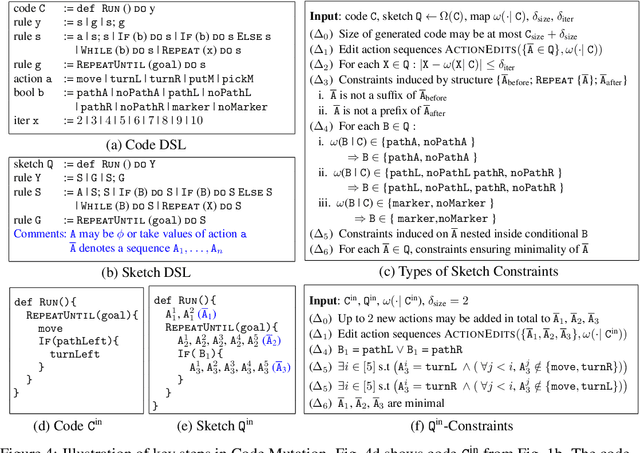

Abstract:Block-based visual programming environments play a critical role in introducing computing concepts to K-12 students. One of the key pedagogical challenges in these environments is in designing new practice tasks for a student that match a desired level of difficulty and exercise specific programming concepts. In this paper, we formalize the problem of synthesizing visual programming tasks. In particular, given a reference visual task $\rm T^{in}$ and its solution code $\rm C^{in}$, we propose a novel methodology to automatically generate a set $\{(\rm T^{out}, \rm C^{out})\}$ of new tasks along with solution codes such that tasks $\rm T^{in}$ and $\rm T^{out}$ are conceptually similar but visually dissimilar. Our methodology is based on the realization that the mapping from the space of visual tasks to their solution codes is highly discontinuous; hence, directly mutating reference task $\rm T^{in}$ to generate new tasks is futile. Our task synthesis algorithm operates by first mutating code $\rm C^{in}$ to obtain a set of codes $\{\rm C^{out}\}$. Then, the algorithm performs symbolic execution over a code $\rm C^{out}$ to obtain a visual task $\rm T^{out}$; this step uses the Monte Carlo Tree Search (MCTS) procedure to guide the search in the symbolic tree. We demonstrate the effectiveness of our algorithm through an extensive empirical evaluation and user study on reference tasks taken from the \emph{Hour of the Code: Classic Maze} challenge by \emph{Code.org} and the \emph{Intro to Programming with Karel} course by \emph{CodeHS.com}.
Towards Deployment of Robust AI Agents for Human-Machine Partnerships
Oct 05, 2019

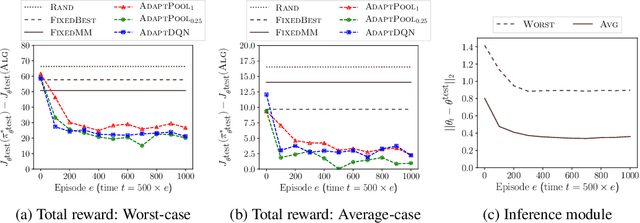

Abstract:We study the problem of designing AI agents that can robustly cooperate with people in human-machine partnerships. Our work is inspired by real-life scenarios in which an AI agent, e.g., a virtual assistant, has to cooperate with new users after its deployment. We model this problem via a parametric MDP framework where the parameters correspond to a user's type and characterize her behavior. In the test phase, the AI agent has to interact with a user of unknown type. Our approach to designing a robust AI agent relies on observing the user's actions to make inferences about the user's type and adapting its policy to facilitate efficient cooperation. We show that without being adaptive, an AI agent can end up performing arbitrarily bad in the test phase. We develop two algorithms for computing policies that automatically adapt to the user in the test phase. We demonstrate the effectiveness of our approach in solving a two-agent collaborative task.
Learner-aware Teaching: Inverse Reinforcement Learning with Preferences and Constraints
Jun 02, 2019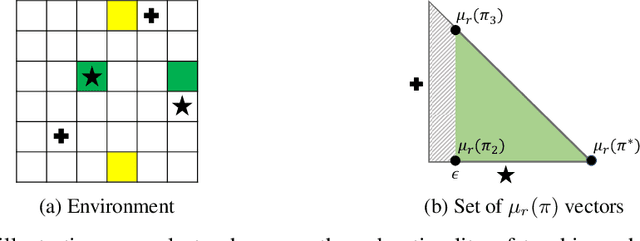

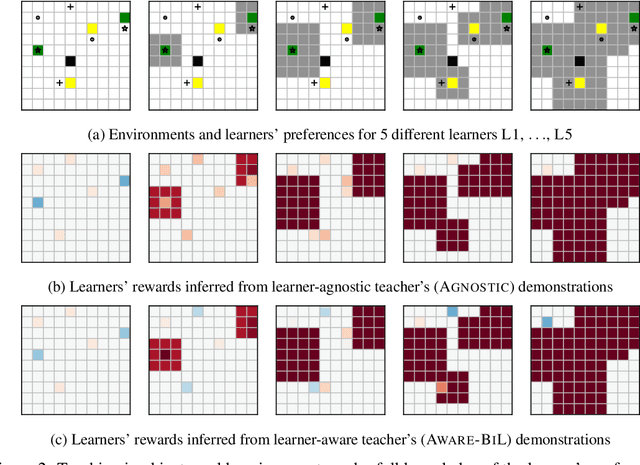
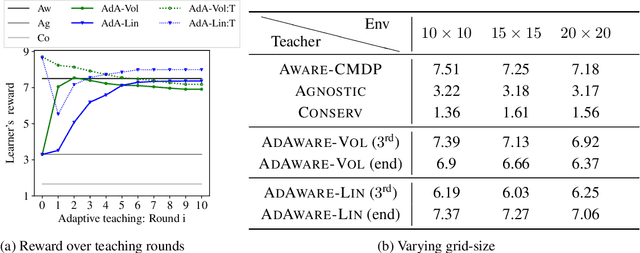
Abstract:Inverse reinforcement learning (IRL) enables an agent to learn complex behavior by observing demonstrations from a (near-)optimal policy. The typical assumption is that the learner's goal is to match the teacher's demonstrated behavior. In this paper, we consider the setting where the learner has her own preferences that she additionally takes into consideration. These preferences can for example capture behavioral biases, mismatched worldviews, or physical constraints. We study two teaching approaches: learner-agnostic teaching, where the teacher provides demonstrations from an optimal policy ignoring the learner's preferences, and learner-aware teaching, where the teacher accounts for the learner's preferences. We design learner-aware teaching algorithms and show that significant performance improvements can be achieved over learner-agnostic teaching.
 Add to Chrome
Add to Chrome Add to Firefox
Add to Firefox Add to Edge
Add to Edge